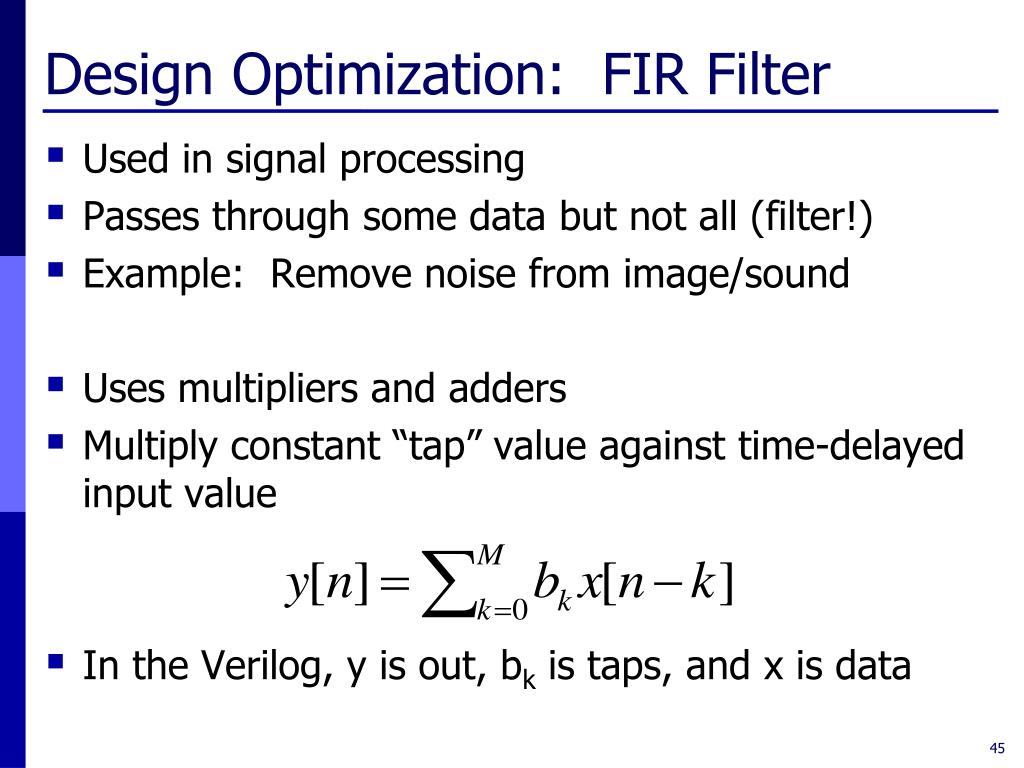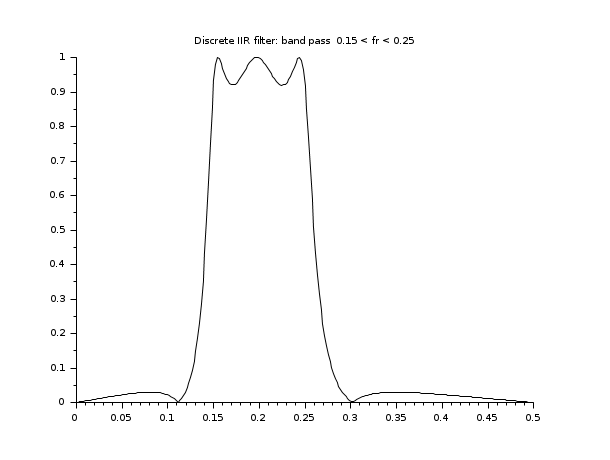
So if we have a zero at z_0 = exp (j theta), and theta is not an integer multiple of pi, then we must also include its complex conjugate at exp (-j theta). To keep the impulse response real, unless you’re including a zero in one of the categories above, you must also include its complex conjugate. These must come in pairs if phase linearity is to be maintained if we locate a real zero at z_0 (and z_0 is not -1, 0, or +1), its reciprocal, 1/z_0, must also be a zero.Ĥ. These make the DC and Nyquist response, respectively, zero.ģ. The zeros come in several categories (the following assumes a sampling rate of 1):ġ. For a phase linear FIR filter, the impulse response will be symmetric.

It is beneficial to work with the zeros of a discrete filter the zeros of an FIR filter define it to within a gain factor. Next Article in Series: Practical FIR Filter Design: Part 2 - Implementing Your Filter Consequently, your design will not match your original specification or the output you simulated in Octave. This is important because without proper scaling you will experience quanitization noise that will affect the frequency response of your filter. Once you have calculated the coefficients it is important to scale and quantize them so you can implement your filter in a microprocessor. In part 2 we will get into scaling the coefficients and other steps necessary to put your coefficients into an N-bit microprocessor. 'low' can be replaced with 'stop' (notch), 'high' (highpass), 'bandpass' (bandpass)įrom the lowpass filter demonstration above it should be easy to form the coefficients (this is the variable hc in the code) for any filter desired. Hc = fir1(round(N)-1, f,'low') can be modified as such: The fir1 function can also be used to produce notch filters, high pass filters, and bandpass filters by replacing these lines:į = /(Fs/2), may need to be specified with two arguments for bandpass and notch filters as such:į = /(Fs/2), where f1 is the left -3dB edge and f2 is the right -3dB edge The filter (in red) is overlaid onto the plot to show how the filter leaves the sinusoids in the passband and attenuates the signals in the transition and stopband. Plot((-0.5:1/4096:0.5-1/4096)*Fs,20*log10(abs(fftshift(fft(xf,4096)))))Īs we can see in Figure 4, we have the time domain signals on the left and the frequency domain on the right.
Scilab fir filter design code#
Let's simulate how it works by adding the code below to the first bit of code we looked at. Gives us a filter which closely matches our speicfications

The bandwidth of the filter is always specified to the -3dB point, so in the first iteration of design our filter has a smaller bandwidth than specified (somewhere less than 9kHz). We can see from the first figure that the attenuation in the stopband exceeded our specifications, perhaps we can tweak the attenuation and passband frequency to enhance the design. The code above gives us the following response:īut if we zoom in we will see that the attenuation at 10kHz is greater than 3dB:
Scilab fir filter design how to#
Using the Octave/Matlab code below, we can see how to design a lowpass filter with a bandwidth of 10kHz and a cutoff of 15kHz using Octave's built in fir1 function, which is well documented here close all *Designing an FIR filter length to be odd length will give the filter an integral delay of (N-1)/2. After trying the calculated N, one can then tweak N or parameters which make up N to meet filter specifications. The equation below is an efficient way to compute a reasonable starting length. You can guess and check until the filter matches your expected bandwidth and cutoff requirements, but this could be a long and tedious process. Typically, in FIR filter design the length of the filter will need to be specified. I won't get into the details much further on FIR filters and their pro's and con's as this tutorial focuses more on designing filters fast and efficiently with the aid of Octave.
Scilab fir filter design series#
As the series progresses, it will discuss the necessary steps to implement the filter on real hardware.Ī FIR filter is a digital filter whose impulse response settles to zero in finite time as opposed to an infinite impulse response filter (IIR), which uses feedback and may respond indefinitely to an input signal.The great thing about FIR filters is that they are inherently stable and can easily be designed to have linear phase.

This tutorial will focus on designing a finite impulse response (FIR) filter.


 0 kommentar(er)
0 kommentar(er)
